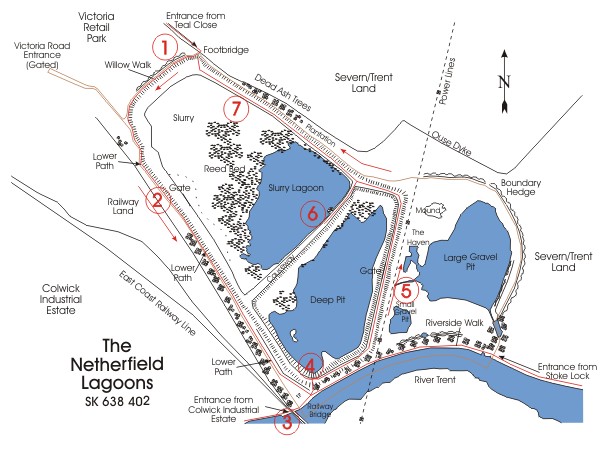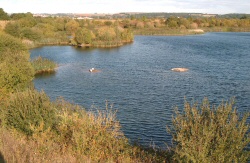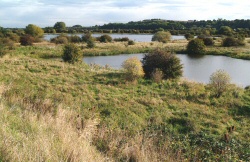Use this guide to take a guided walk around the Netherfield Lagoons Local Nature Reserve, Nottinghamshire, including seven points of interest and details of some of the wildlife on offer at the reserve.
Standing at the end of Teal Close in Victoria Retail Park, cross the Ouse Dyke, opposite the Aura Designer Furniture factory. Turn right along the Ouse Dyke and follow the path for approximately ¼ mile to the footbridge. Cross the footbridge and enter the Netherfield Lagoons Local Nature Reserve.


1. Willow Walk
The path splits in two, one going up the steps and the other, Willow Walk, runs along the northwest edge of the reserve. Follow Willow Walk. In winter the dense scrub on your left usually holds good numbers of Redwings and is often used as a refuge by Tree Sparrows and finches when a Sparrowhawk is about. Further along there are several old willows with their branches spread-eagled over the ground. Here there is sometimes a Tawny owl roosting in the thicker cover and there may be Goldcrests and Tree Creepers. In the summer the scrub is good for Willow Warblers, Chiffchaffs and Lesser Whitethroats. At the end of Willow Walk you will reach a more open area. Cross this and go through the cycle trap and turn left.

2. Lower Path, Ford
You are now on the Lower Path, which runs along beside the railway embankment to the river. In the summer this is a good place to find Whitethroat, Blackcap and Chiffchaff and there is also a good chance of seeing Willow Tits. The banks can be alive with small birds and autumn brings large flocks of warblers and tits, which especially like the flower heads of Angelica, which abounds along this path, for its attendant pollinating insects. About half way along the path is a small ford, which is normally dry and easily passable but can be flooded in very wet conditions. This can be a good site for Water Shrews and, on the pool to your right, Kingfishers. In autumn the trees to the right, on the railway embankment, sometimes hold Spotted Flycatchers. Continue along the path until you reach the river.

3. Railway Bridge
To the right is the railway bridge, which, in summer, has a small colony of Swallows nesting under it. Grey Wagtails nest below the walkway. This is also a good place to see a Hobby, normally given away by the alarm calls of the Swallows. In October 2007 a Dusky Warbler was found on the other side of the bridge and in May 2001 a Little Swift spent three nights roosting on its brickwork. Retrace your steps and make your way up the steps to look down on the Deep Pit.

4.DeepPit
Turn right and walk east along the Deep pit bank top. In summer a colony of Common Terns nests in the Deep Pit on the rafts placed there for them. In winter the Cormorants like to sit on them and in winter the reed beds may hold a Bittern. As you walk along the bank look out for Goldfinches on the Teasels and Stonechats in winter. In summer the reeling of Grasshopper Warblers can be heard at several points along the bank (the site has held up to twelve singing males).

5. Gravel Pits
As you walk along the path turns more to the north, parallel to the power lines, and, in the right seasons, Grasshopper Warblers and Stonechats can be found anywhere along its length. To the right or east, are the Large and Small Gravel Pits and patches of scrubby grassland. In summer the two pits are very attractive to dragonflies and damselflies and up to ten species can easily be observed. In winter the Large Gravel Pit is host to a good flock of Wigeon and sometimes several Red-crested Pochard or Smew. On passage the area can turn up Whinchat and Redstart and a Marsh Warbler spent two days here in June 1997. The path continues to the left along the northern end of the Deep Pit and then the Causeway joins it from the left.

6. Slurry Lagoon
Go left along the Causeway. On your left is still the Deep Pit and on the right is the Slurry Lagoon. The Slurry Lagoon holds good numbers of breeding ducks, including Mallard, Gadwall, Tufted Duck and recently Pochard. In winter immigrants as well as Teal, Shoveler and Golden-eye swell their numbers and there is an impressive gull roost, which may contain a Glaucous or Iceland Gull. Halfway along the Causeway is a seat, which is a good spot to scan the water for more unusual species such as Black-necked Grebe, Garganey, Mediterranean Gull or waders. A Buff-breasted Sandpiper was found here in 1992, a Purple Sandpiper in 2004 and a Spoonbill in 2006. From here you could expect to hear Cetti’s Warbler and Water Rail and scanning the skies you might spot a Buzzard or Peregrine. During passage this is the best place to be to catch waders, gulls, terns and raptors going through. This has also been a good place to see Bittern and Bearded Tit from in the last few years. The reed bed in the Deep Pit behind you held a Great Reed Warbler in June 1997, which stayed for nearly three weeks (the second county record). The reed bed on the Slurry Lagoon has attracted Spotted Crake and Great Reed Warbler in May 2016 (the third county record).

7. Dry end of Slurry Lagoon
Retrace your steps and turn left to walk along the side of the Slurry Lagoon. In spring this area is alive with Reed Warblers, Sedge Warblers, Grasshopper Warblers and Whitethroats and there are large colonies of Marsh, Spotted and Bee Orchids. The lagoon has held Grey Phalaropes on a couple of occasions as well as Avocet and in 1997 a Stone Curlew. Further along the Slurry Lagoon on your left dries out and is worth checking for Little Ringed Plovers in the spring and Wheatears on passage. The dead ash trees on the right have held Spotted Flycatcher and Redstart and the thick scrub holds several pairs of Garden Warblers in summer. At the end of the path are the steps that take you down to the footbridge and the Ouse Dyke path back to Teal Close. Pause at the top and scan the scrub below you. In autumn this area is good for warblers fattening up on elderberries before they migrate and Lesser Whitethroat is commonly seen here.
How far? Approx. 3 miles
How long? Rather depends how long you spend overlooking the different pits. Non-stop 1 hour.
How easy? Generally flat on good paths. May be a bit muddy after continual rain.
Public transport. There is a shoppers’ service to the retail park and Teal Close is close to the bus stop.
Location. (Grid Reference: SK638402) The Lagoons are situated south of Netherfield, Nottinghamshire, between the Victoria Retail Park and the river Trent and can be reached by turning south off the Colwick Loop Road. View Map.
Car parking. Park at the roadside on Teal Close.
Refreshments. Morrisons on the retail park has a restaurant, where light snacks or a full meal can be purchased.
Toilets. The nearest toilets are also in Morrisons.
Dogs. Dogs must be kept on a lead at all times.